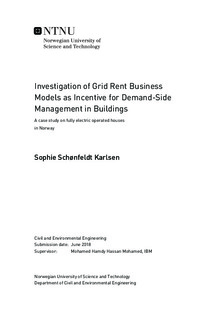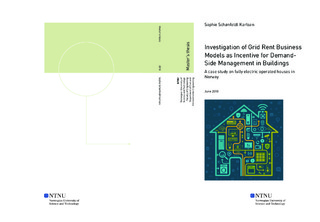| dc.description.abstract | The increase in power drain on the grid, and increased penetration of inflexible, renewable energy sources, is creating a need for reduction in peak demand on the grid and matching the demand with supply, by demand-side management. Demand-side management techniques aim at reducing the system peak loads, the operational cost, and provide the customers with the greater control over their energy consumption. Demand-side management can increase the matching between supply and demand, and reduce the power peaks to ensure that the power drain is within the capacity limit of the grid. To give incentive to load shift and reduction of peaks in buildings, NVE want to introducing a new grid rent tariff by the end of 2020. They are suggesting three different business models for grid rent, with either higher cost for higher power drain (Measured power tariff and Tiered rate tariff), or higher cost during high demand periods (Time of use tariff).
The object of this thesis has been to investigate the three models for different building cases, with the aim to detect which model gives the better incentive for demand-side management in buildings. As the larger amount of the total electricity consumption in Norway is used for space heating in households, space heating has been investigated with load shifting. Heating can, with improvements in building physics, be a shiftable load. Heat load shift creates a large potential for peak reduction on the grid, and could result in a more efficient use of the grid.
The research includes investigation of which business model that gives the largest economical incentive to improve building physics, and largest incentive to shift loads, which one is the most achievable, and which will give the lowest total cost for the end-consumer. To be able to perform the cost calculations, an algorithm has been developed in Excel. The algorithm is calculating the total cost of the different tariffs, the ideal heat load shift of the buildings, and the savings per kWh of load shifted. A single family house is constructed in the simulation software IDA ICE, according to the requirements from the current Norwegian standard TEK17. The energy demand is simulated with IDA ICE, and the cost is post processed with the developed Excel algorithm.
The results show that for different building cases, different tariffs give the best incentive to building physics improvement and load shift. An implementation of any of the suggested three tariffs will increase the grid rent for customers whom continue to use electricity with the typical consumption pattern of today. Improvements in building physics reduce the grid rent cost, both due to reduction in demand and change in demand profile. With ideal heat load shift, all the business models obtain a lower price for the investigated cases than the tariff model used today. This indicates that the models will work as incentive to load shift and a change in consumption pattern.
The Measured power tariff have the smallest daily heat shift necessary to obtain the maximum cost reduction. With heat shift, this tariff also give the lowest annual grid rent cost for most cases. But this tariff give incentive to shift loads all day, all year. The Tiered rate tariff have the largest cost saving per kWh of shifted heat, and a small amount of ideal heat shift. But for most cases this tariff result in the highest annual cost. The Time of use tariff have the largest amount of heat shift necessary to obtain the maximum cost reduction, and the smallest cost saving per kWh. But the tariff is the most accurate regarding which hours the shift is encouraged to happen. | |

